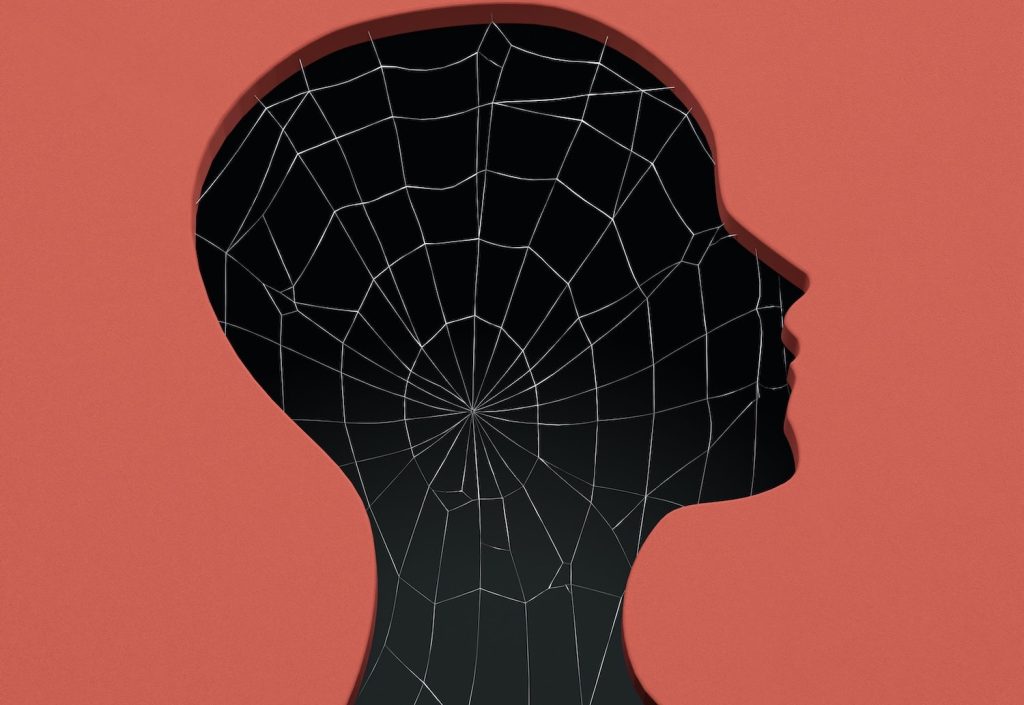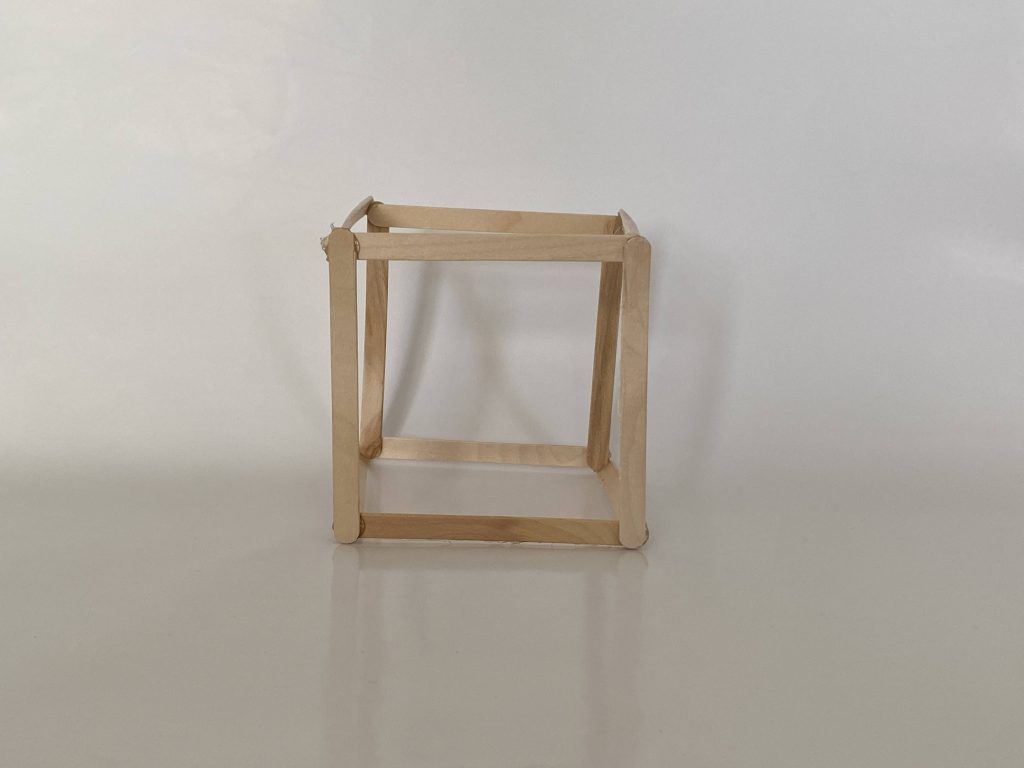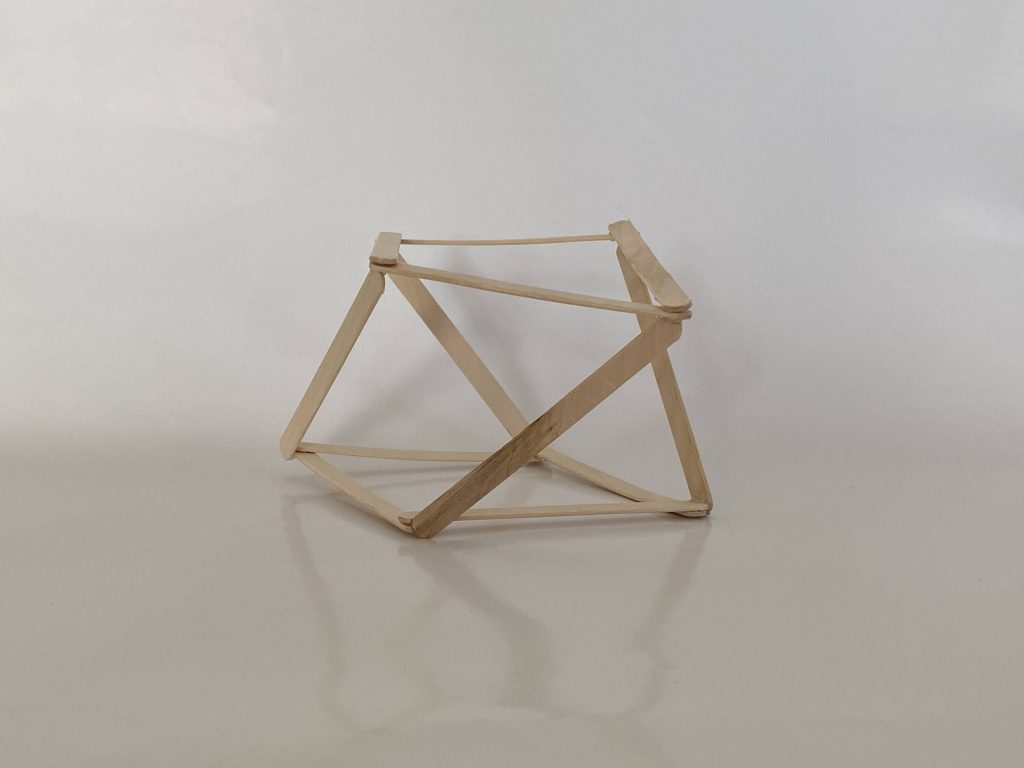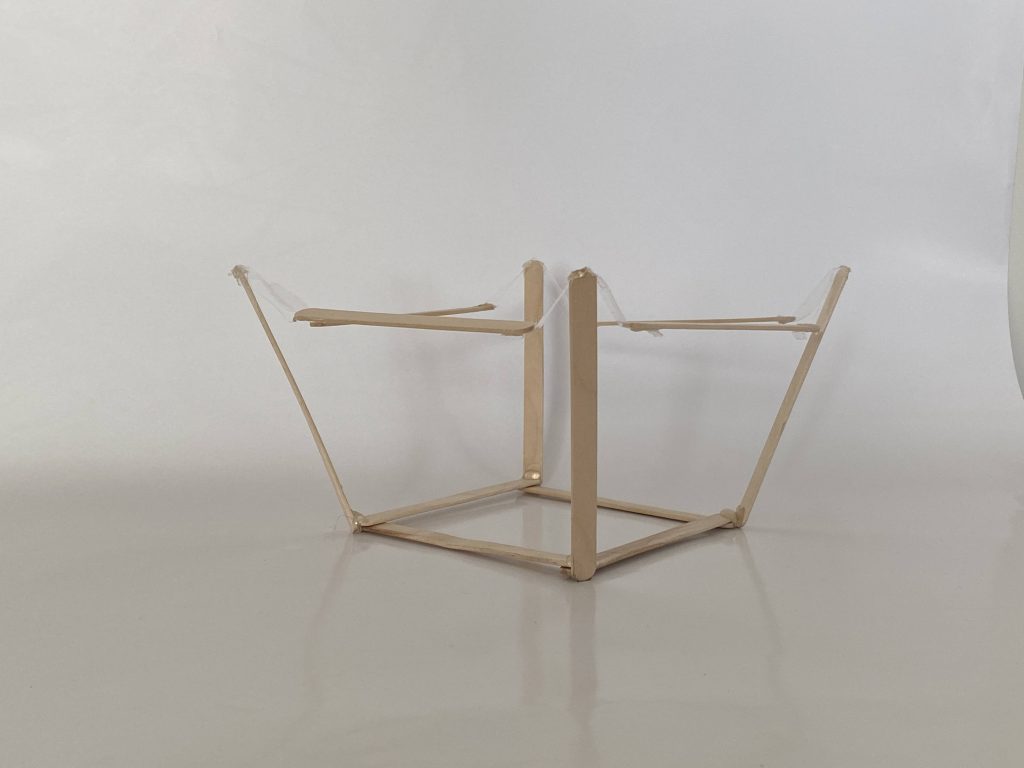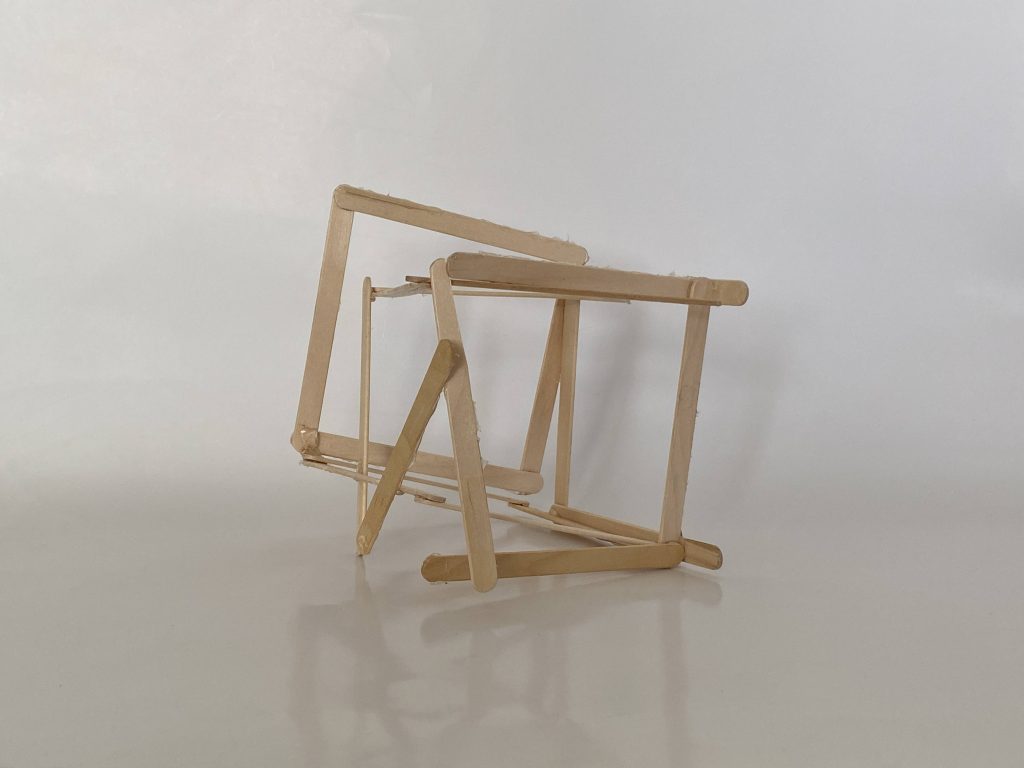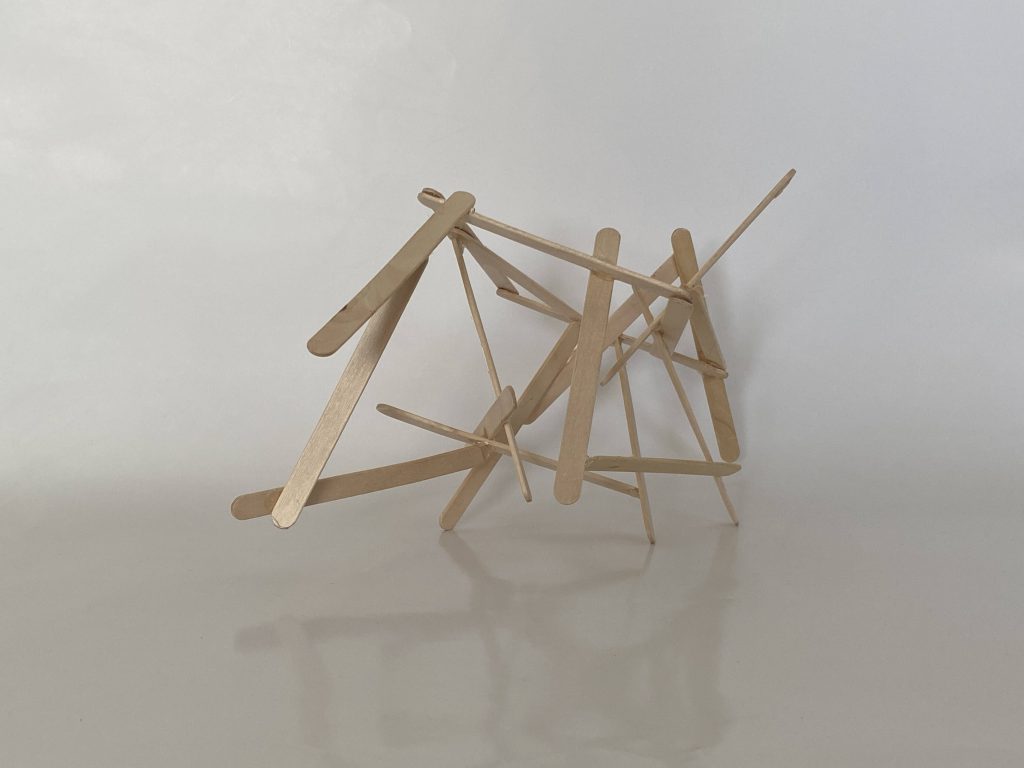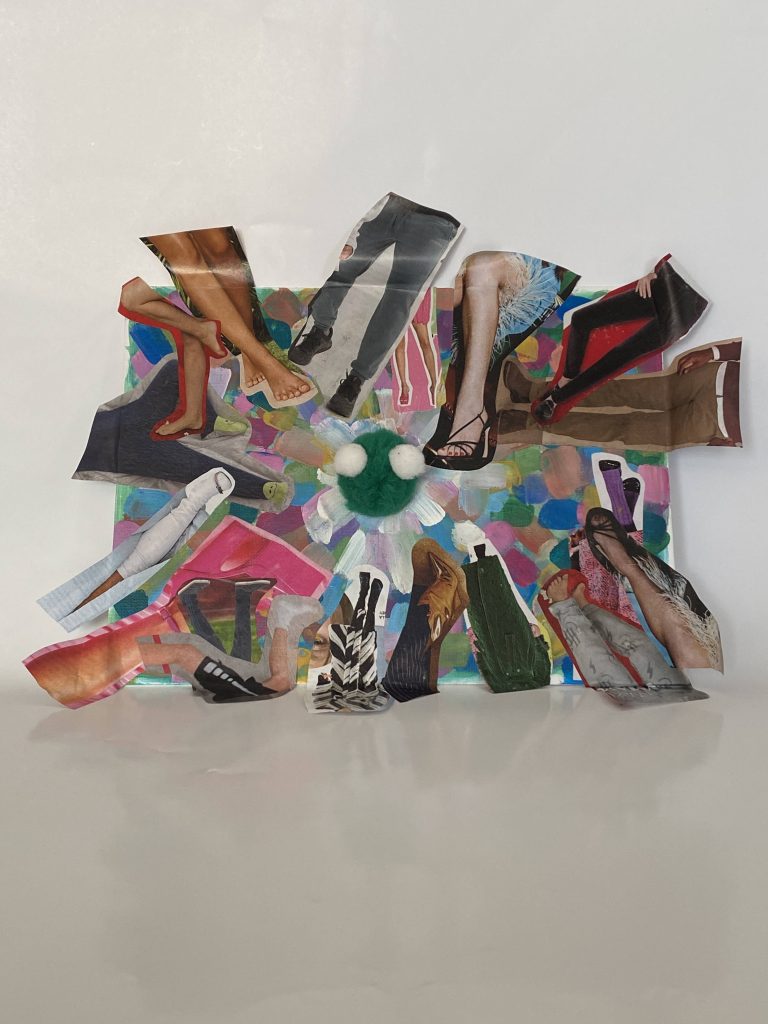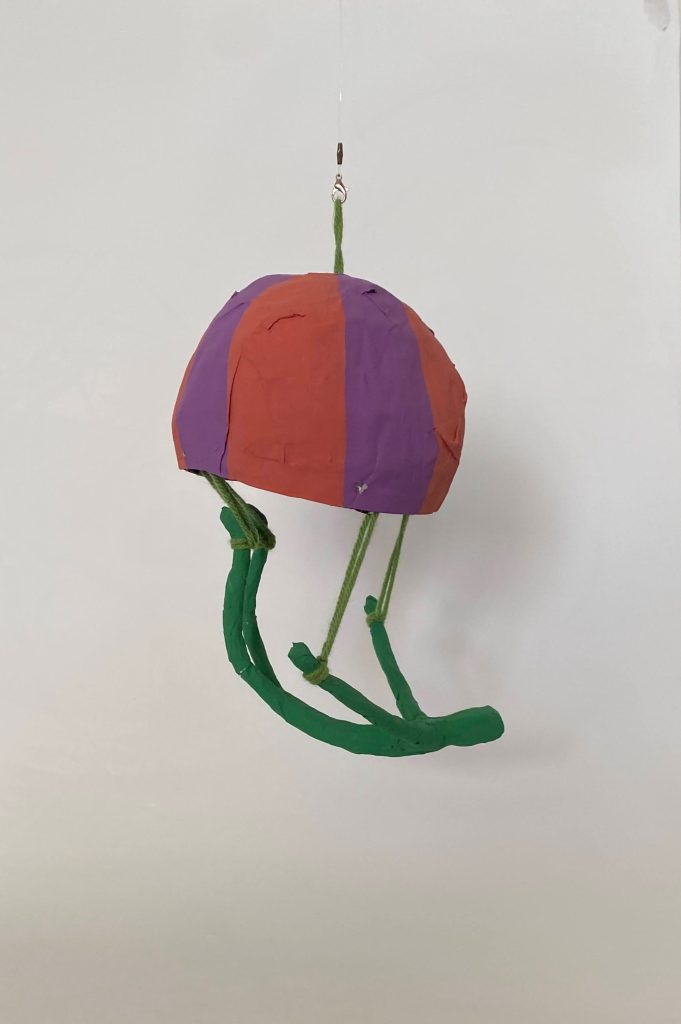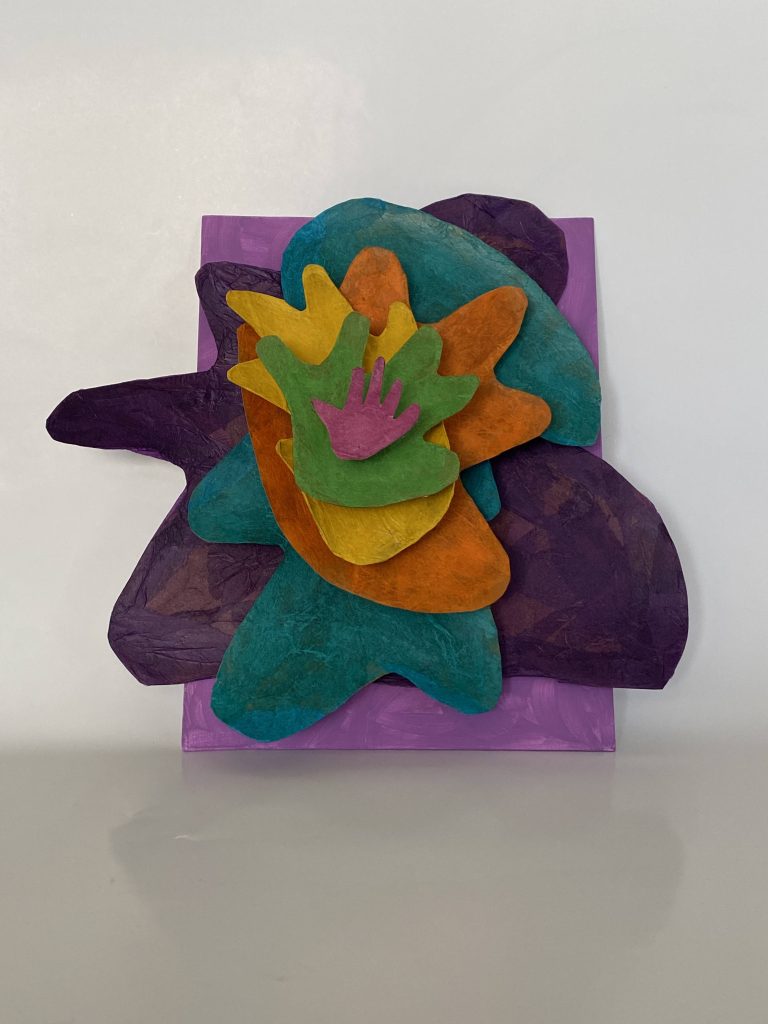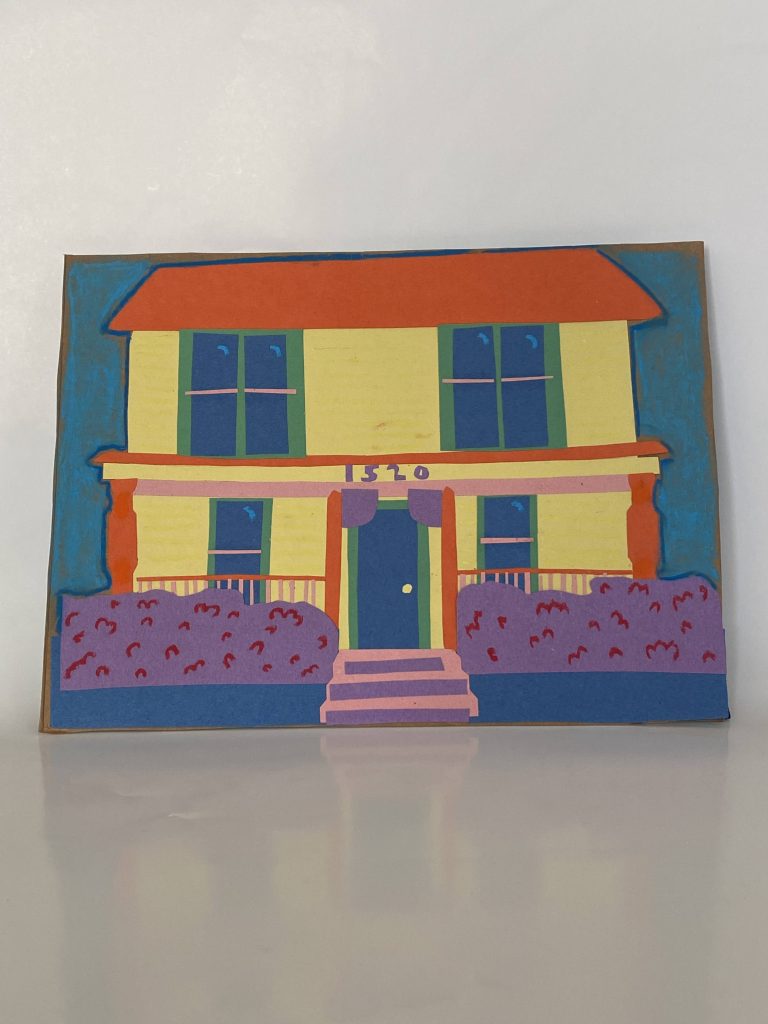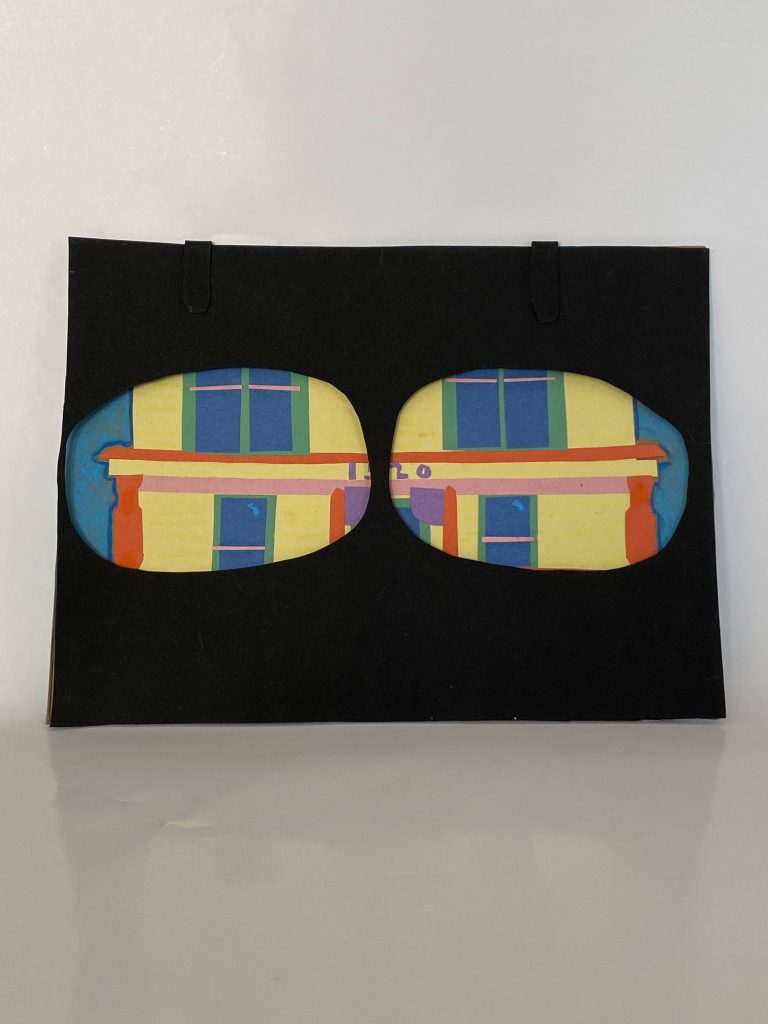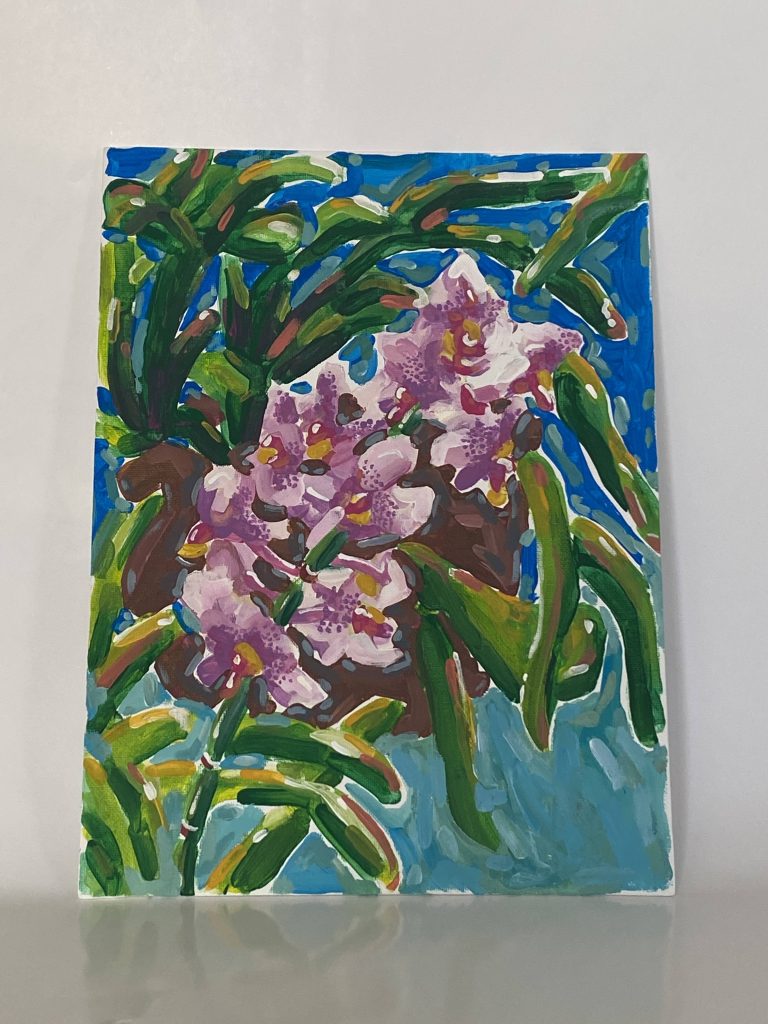Negotiating Research:
A Visual Study of My Mental Metaphors
by Marti Wolf
Derived from my scholarship on ableism in horror films, this project challenges dominant modes of empirical research and invites researchers to recognize and validate their own experiences. I analyze my challenges over the course of my research project and present these findings through multimedia visual art projects and accompanying writings. Through the lens of metaphor, I articulate how I have not felt like a real researcher and how I have come to reconcile the ideal Researcher with the realities of being a student researcher. I found through my initial research project and the development and presentation of this reflection that The Researcher is an image we are taught to uphold and internalize, generating a sense of shame that can promote isolating research practices. Through internal and communal work to deconstruct this image, we can begin to create supportive spaces for researchers, work more collaboratively, and present more honest accounts of the unseen labor of academic research.
research communication, visual art, methodological reflection, alternative research
Introduction
The project that spurred this endeavor was a comparative analysis of the screenplays of Halloween (1978) and American Psycho (2000). I used these texts to examine how able-bodied people, both characters and screenwriters, constructed and stigmatized disabled antagonists. I also considered how disabled antagonists resisted labeling, exercised autonomy, and created counterimages of disability. This piece is not a description of my findings but a reflection on the social, emotional, and conceptual learning I did throughout my research project. After a reflection on my experiences as a whole (pieces 1–3), I recount how these developments interact with the chronological progression of my research (pieces 4–6).
I found through my research process that research is more challenging than reading scholarly articles had led me to believe. Research demands flexibility and discomfort and change, and I found myself struggling with these emotional demands, my inability to get it right or accept that research, by nature, can never be right.
Reckoning with this paradigm shift, I began to explore in greater detail the imperfections of the learning process. Current means of sharing research obscure the challenges of aligning research practices with their ideal theoretical forms. Most of the research we interact with as students is published in academic journals. By the time we read it, it has been carried out and polished over the course of years, reviewed and edited by many experts and sustained by the researcher’s unseen support network. Without considering those factors, it seems as if the researcher were simply able to will new knowledge into existence, creating an inflated image of The Researcher who does not share the kinds of concerns or panic we may endure as new researchers. It is also easy to assume that our peers, those at similar points in their research trajectories, are also Researchers while we flounder as mere researchers. In doing so, academic research can create an isolating feeling of incompetence for new researchers that deters further engagement.
We can challenge this detachment by being more emotionally transparent and honest with our fellow researchers. If we know our peers share the doubts and difficulties endemic to research, we may feel more comfortable occupying this sometimes alienating space. By sharing the inflection points of my research process as a reflection of my experience, I model vulnerability and transparency when communicating with other researchers. This shift in the culture of research is a vital step that can facilitate community building and preclude feelings of isolation and estrangement. I have had to reckon with my imperfections as a researcher, and I hope that sharing my internal process, visualized in these pieces, will challenge the conventional image we may hold of The Researcher.
Part 1: Reflections
These pieces are a visual representation of my perception of the research process as a whole.
1. Geometric Sequence
Coming from sociological research methods, I understood research as a rigid and finite being, worthy of my awe and devotion. In some ways, “research” felt more like a deity than an undertaking, existing beyond my understanding and produced through some divine process I could not begin to unpack. Research existed in the space of geometry, much like the cube and its series of neat, regular, and particular shapes. My simplistic view aligned with empirical, colonial thought (Figure 1, Closed), but reading Gloria Anzaldua’s work on conocimiento set me on the path to understanding research as a process of expansion, fragmentation, and adaptation (137).
Next came the expansion of the self within the frame of research, deforming the frame as it struggled to contain the changing self. By learning concepts like refusal (Tuck and Yang 814), compromised agency (Liboiron 519), and standpoint theory (Hill Collins 516), I felt myself begin to outgrow the limits of traditional research. I practiced the rigid empirical constructs I had been taught, but my growing awareness of research ethics, my power as an embodied researcher, and the exchange between the researcher and the researched taught me about the necessity of expanding and challenging the limits of conventional research. Rather than feeling cowed by research as a concept, I recognized the utility of research, how human it is, how it is bound to be flawed. The frame does not fundamentally change, but the understanding of the self within it does, translating to the slight warping of the form (Figure 2, Warped).
The process of simultaneously learning and doing research generated the most substantial shift in my perspective on research throughout the course. I had to confront logistical challenges in my work, altering coding schemes and analysis while recognizing my own capacity for harm and insensitivity through the mishandling of research. This iteration of research can no longer be described by the geometry of the cube, as the boundaries of traditional research fail to encompass its complexity. It does not acknowledge the nuances of balancing compassion and rigor. The cube breaks down into its component parts, and I am left to assemble them without replicating the rigidity of their original form (Figure 3, Open).
As the outrage and overwhelmedness of the process began to settle and I reconciled a radical feminist epistemology with the traditional research frame, I began to create something of my own—a style, a voice, a perspective, a frame, a doctrine. My reassembly is imperfect and disjointed, no longer the first frame but acting as its relative. Though I have formed this shape myself, it still too closely resembles its predecessor, and I understand that the original frame is inherently flawed, no matter how large or bent I make it (Figure 4, Reassembled). As I continue to do research and learn about the nuances of executing it, I find that the geometry of the cube is no longer adequate for my perspective. Instead, I propose a synthesis of the geometric and organic, something with the structure of geometry and the recognition of compassion, the inevitability of flaws, authorship, cooperation, and flexibility of feminist research (Figure 5, Reconfigured).
2. I Don’t Know Where I Am or How I Got Here
This piece represents the feelings of inadequacy and overwhelmedness that dominated the beginning of my research process. In a public research institution where instructors are established researchers, being a student feels like a position of weakness. Like I am at fault for still needing to learn. Feeling so small among giants felt permanent, like I could not grow to their height. As a person who has not physically grown since the seventh grade, this was a familiar tune that preyed on my self-consciousness and self-efficacy. Reaching out for help seemed impossible; I felt uncomfortable making the climb up to them and calling to the people occupying those strata. Asking them to kneel down to speak with me felt like an imposition, a request to diminish or temporarily forfeit their status as experts.
Eventually, I recognized my position as a student and the growth that will come with continued learning. The people I see as giants were once my size too. Zooming out to understand the trajectories of education, gaining perspective on my position rather than heeding my anxieties, diminished that feeling of permanent smallness. I see that feeling overwhelmed and disoriented and intimidated is a temporary and isolating condition. Feeling small and subjecting myself to comparison to experts and people at different stages of their education made me hesitant to seek community and guidance from those above me. I resigned myself to that position. Perspective is a necessary reminder of the dangers of comparison and isolationism. I was once smaller and will become bigger.
3. Terminal Velocity
In this sculpture, I attempt to capture motion. The process of thinking about and doing my qualitative analysis regularly felt like jumping and letting myself fall. Terminal velocity is the point in freefall (when the only force enacted on an object is gravity) when the force of gravity accelerating a falling body towards the earth is equal to the force of air resistance pushing upward against the body. Preceding the point of terminal velocity, the downward force of acceleration due to gravity exceeds the upward force of air resistance, meaning a body falls faster and faster each second it is in the air. In a much less terrifying way, I found that doing research has been a process of negotiating gravity and air resistance, my fears and my abilities respectively.
In the beginning of my project, as represented in Geometric Sequence and I Don’t Know Where I Am or How I Got Here, there is a sense of pressure and fear I associate with the anxiety that builds in the pit of my stomach. I feel like I am hurtling toward the ground faster and faster, slightly nauseous, as I panic and attempt to make strategic choices that will halt my freefall. Making decisions is necessary, but the fear that I am making the wrong ones is immobilizing. I am disoriented—time is passing and I get closer to the ground each second I resist making peace with my situation. When I accept the necessity of making choices to move forward, I allow my confidence in my abilities—air resistance—to counteract my sense of fear and anxiety. I gather my thoughts and draw on the class readings in hopes of feeling at peace with the contradictory forces of fear and competence. I work to sustain terminal velocity.
Part 2: Inflections
These pieces are a visual representation of my perception at key points in the research process.
4. De-Abstraction
This piece speaks to the process of narrowing and shaping a research question. What begins as a broad, flat surface becomes more sharply defined, narrower in breadth but greater in depth. Guided by Foss and Waters’ work on creating a research proposal and defining your question—as well as the advice of professors across disciplines who have encouraged me to narrow my topics, concentrate my ideas, and minimize the sprawling ideas in my papers—I may have started to learn my lesson (47). Most often, the metaphor for this narrowing process is a funnel, where the broadest ideas at the top become narrow as you progress. When visualized like this, I imagine it as a process of distillation, of minimization, that produces the clearest idea but, through this downward filtering, loses the heart of what brought us to the broadest iteration of the idea.
By flipping the funnel and imagining the refinement process as a quasi-pyramid, I understand it as a construction of ideas from the most basic and foundational to something that while, yes, narrowed in scope, is the product of layers of questioning and building. It is something created through intentional shaping and carving, reliant on what lies beneath it to reveal something that synthesizes the value of each layer. Rather than a triangular pyramid, I use the form of a hand emerging from the layers to express the individuality and unique craftsmanship that each person brings to the construction of their question. A handprint is a signifier: “I was here.” I am reminded that this process of forming a question is not just an effort to fulfill criteria but to bring my own touch to scientific discovery. Through my question and its intentional construction, I feel attached to my work and proud that my efforts to begin the project bear my mark, showing that I am, in fact, here.
5. Seeking Anonymity
This piece speaks both to the content of the films I studied for my project and the concept of reflexivity as a process of discovery. Halloween follows the silent, teen-slashing masked killer Michael Myers. Michael does not speak for the entirety of the film, a way of dehumanizing him and making him more threatening—an unknowable, cold-blooded slasher. The only subjectivity Michael does receive is visual; we often see through his eyes as he stalks teenagers, the cutout eyes of his mask ratcheting tension as the viewer realizes how close he is to his next victim. The visuals of Halloween allow for discussion of the ways spectatorship can go unnoticed.
In film theory, some scholars study spectator theory to understand how a viewer’s identity and relation to the film may shape their viewership (Magrini). One such theory is suture theory, the idea that the camera is strategically positioned so that the viewer feels as if they are sewn into the narrative. This is how I’ve come to understand positionality.
Positionality is a researcher’s process of recognition and adaptation as they realize how their social identities, experiences, and physical presence may shape their project. In the original picture (Figure 6), positionality is represented by an image of a house. It can be studied for detail and the viewer can interpret the image and its meaning however they see fit. Once the overlay is placed over the house, it becomes clear that either the viewer is engaging in some kind of voyeuristic spying or stalking, much like Michael Myers (Figure 7). The masking of the frame reminds the viewer of the active role they play in looking, while the unframed piece alone may convey a neutral image that does not invoke considerations of viewership. Positionality statements differ in their descriptions of and attitudes toward positionality, exemplified by the comparison of those by Hoang (181) and Rivers-Moore (179), but all of them act as the filter over the picture, showing how their agency as viewers colors their interpretation of the data and our own interpretation of their work.
Positionality is the continuous effort to remind myself of the metaphorical binoculars I am looking through.
6. Standing Too Close?
I thought pointillism would be a fitting final representation of my research journey. This style rejects classical standards of painting, navigating the line between abstract and realistic to become recognizable in its own right. I was inspired by Georges Seurat and his piece A Sunday Afternoon on the Island of La Grande Jatte, arguably the most recognizable pointillist artwork, whose meaning is explored in Ferris Bueller’s Day Off (1986). Director John Hughes said in an interview about the inclusion of this painting in the film that “[y]ou don’t have any idea what you’ve made until you step back from it. The more [the character] looks at it, there’s nothing there. He fears that the more you look at him, the less you see” (emphasis added) (Judkis). I resonated with this perspective and felt that exploring this uncertainty could capture my thoughts on maintaining the appropriate distance from my work.
How a viewer understands a pointillist painting is dependent on their distance from the canvas—too close, and all you see are individual dots of color; too far, and the image loses its texture. I have come to understand research through a similar lens. Decisions about methods and sample selection easily overwhelm me; I am so focused on the dots and the individual colors that I forget the painting will be a complete image. If I recognize this fixation, I tend to move toward the opposite extreme, thinking about how the project will look at the very end and paying no mind to what I as the “artist” do to generate that image. By continually shifting between these modes of observation, the viewer and the artist can understand the relation between micro details and macro product, helpfully altering their approach to each.
I find that Max Liboiron captures this phenomenon in their writing, traversing both specificity and generalization in complementary ways. In “The Case of BabyLegs,” they discuss the details of their product and how they made it appear hyperfeminine—crossing its legs, using childish stockings, naming it BabyLegs, and referring to the device as “she” and “her” (513). Up close, we can see how these details work together to create something that challenges traditional standards of engineering and science technology. From a distance, Liboiron discusses intellectual property (IP) and academia’s exploitation of IP law to “protect” staff and student research while profiting from it. Liboiron’s decolonial emphasis on low costs and accessibility conflicts with the structures of a classist capitalist system like the university. In bringing these ideas together, we see how the hyperfeminization of BabyLegs works against the university’s purview of “legitimate” science and how the understanding of the macro enables strategic use of the micro. Liboiron manipulates the dots, always keeping in mind the greater image being produced, exemplifying this artistic style and the demands of its creation and viewership.
Conclusion
I produced art that synthesized scholarly thought and my personal experience as a form of self-expression. I hoped that this medium would allow me to engage with my classmates in a way I could not achieve through a paper. I also felt uncomfortable creating and sharing my project.
I was worried it would not be received well, that my fellow researchers would see my work as a frivolity that lacked the rigor and methodological insight of a more conventional reflection. But, in reflecting on my experience, I realize that, although I stressed the importance of vulnerability as a way to help others challenge and deconstruct The Researcher, I had not done so myself. My assumption that my peers were Researchers, as I note in the introduction, spoke more to my anxieties about judgment in academic spaces than to reality.
By assuming that others would view my deviation from traditional academic mediums as invalid, I was projecting my internalization of The Researcher. I was, without thinking, policing my own work through the lens of rigid and strict academic authority, directly contrasting my goal of building communities that counter such staunch empiricism. I was tempted to abandon my project and return to the safety of a paper, but as I moved forward and visually explored the feelings and ideas I could not have expressed through a paper, I understood that the fear of deviation, of facing judgment for developing one’s own identity as a researcher, is what upholds The Researcher. Introspection throughout this process of creation helped me root out my inflexible ideas of what research and research communities could look like.
After I presented this reflection, the same people whose criticism I had feared told me how cool they found the art and how it had helped them rethink familiar concepts. Seeing that my work foregrounding myself as a complete, complex, and unique researcher could be a “valid” academic product weakened my belief in The Researcher. I was not alone in my alternative imaginations of research and academia; I was embedded in a community of people who were also developing their identities and sensibilities as researchers. The Researcher was an imaginary impediment to my progress. Upon realizing that The Researcher and my fear of judgment no longer held power over me, I was free to explore unconventionality.
In reckoning with the communal code of silence around the difficulties of the research process, I gained a new understanding of barriers that may deter researchers from being vulnerable and challenging dominant forms of academia. By believing in the flexibility and receptivity of our research communities despite The Researcher narrative we may unknowingly cling to, we can reconfigure research to create something beyond the limitations of convention.
Works Cited
Anzaldúa, Gloria. 2015. “Now let us shift…conocimiento…inner work, public acts.” In Light in The Dark/Luz en lo Oscuro: Rewriting Identity, Spirituality, Reality, edited by Analouise Keating, pp. 118–156. Duke University Press.
Foss, Sonja and William Waters. 2016. “Planning the Trip: The Conceptual Conversation” and “Formulating Your Research Question.” In Destination Dissertation: A Traveler’s Guide to a Done Dissertation, 2 nd ed., pp. 25–34. Rowman & Littlefield.
Collins, Patricia Hill. 1986. “Learning from the Outsider Within: The Sociological Significance of Black Feminist Thought.” Social Problems, 33(6), pp. S14–S32.
Hoang, Kimberly Kay. 2015. In Dealing in Desire: Asian Ascendency, Western Decline, and the Hidden Currencies of Global Sex Work, pp. 181–195. University of California Press.
Judkis, Maura. 2011. “John Hughes video explains ‘Ferris Bueller’ scene at Art Institute.” Washington Post, https://www.washingtonpost.com/blogs/arts-post/post/john-hughes-video-explains-ferris-bueller-scene-at-art-institute/2011/11/16/gIQAZBAERN_blog.html
Liboiron, Max. 2017. “Compromised Agency: The Case of BabyLegs.” Engaging Science, Technology, and Society 3: pp. 499–527.
Magrini, J.M. 2006. “On the System of ‘The Suture’ in Cinema.” Other Cinema, 10. http://www.othercinema.com/otherzine/archives/index.php?issueid=15&article_id=33
Rivers-Moore, Megan. 2016. “Methodological Appendix.” In Gringo Gulch: Sex, Tourism, and Social Mobility in Costa Rica, pp. 179–188.
Acknowledgements
I am grateful to Christina Crespo for her guidance throughout this unconventional project and her dedication to changing academia one student at a time. This project would not exist without my classmates and our discussions, which shaped my understanding of learning and research as a collective process. Most importantly, I want to thank my mom, Barb Wolf, for being endlessly patient with me, for listening, advising, and loving me. Her support, encouragement, and honesty have made me the kind of person who can produce a project like this. Special thanks and much love to my cat, Honey, who kept me company and tolerated my mess during the creation of this project. She is the light of my life and the reason I get up every day (literally—she wakes me up at 7 a.m.).
Citation Style: MLA
